Quality of the Environment in Japan 1994
Environmental Impact Appraisal for Products
To respond to the growing complexity of environmental problems, such measures as clarifying the causes of existing pollution problems, establishing procedures to curtail the discharge of pollutants, and revamping the physical makeup of products themselves are necessary.
In examining ways to manufacture and assemble environmentfriendly products, businesses must consider recycling methods at the design phase of first-stage products (batteries, automobiles, etc.) and undertake preliminary appraisal of component materials and structures to ensure that recycling is feasible. Such aspects as the characteristics of the materials used (recyclability), the structure of the components (processability), the ability to divide and extract parts (separability), and assurances of security in production (capacity for safe processing) need to be considered from an environmental perspective at the productdesign stage.
Existing environmental appraisal systems usually take into account only the lifecycles of the products themselves. These include evaluations of emissions of CFCs or other specific substances during product use or waste disposal ; emissions of harmful substances from waste by-products; ease of processing and disposal ; ability to recycle materials after use or enhance product decomposition, and the proportion of recyclable materials or raw materials affording minimal environmental impact used.
Thus, although the environmental burden of a product during its use and waste-composition stages may be minimized, the overall effect in reducing adverse environmental impact may be minimal because the resource extraction, manufacturing, and distribution phases are also important. Today's domestic environmental problems arise from a broad range of socioeconomic activities that are carried out throughout the nation. Rather than merely preventing the emission of specific pollutants and treating the symptoms of problems that arise, it is imperative to appraise and transform the broad-ranging social and economic behavior of the nation to minimize stress on the environmental. To this end, Article 24 of the Basic Environmental Law specifies "promoting the use of products that reduce environmental impact."
Therefore, comprehensive environmental-impact appraisal procedures for every stage of product life are required. Lifecycle Assessment (LCA) is an all-encompassing appraisal method for determining a product's environmental impact through all phases of production, consumption, and final disposal. LCA provides procedures for critical environmental evaluations of raw material procurement methods, production, transportation, product use, and disposal.
LCA has gained worldwide attention in recent years, and research on its adoption is under way in many countries. In Switzerland, for example, the Home Affairs Ministry of the federal government has selected energy consumption, atmospheric pollution, and waste products as specific research categories, with studies focusing on LCA methods to assess packaging materials and create environmental-impact databases. Major industries are cooperating in reviewing the types of packaging materials based on LCA methods and information culled from the databases. In France, researchers are gaining a broad understanding of the detrimental influence that the production of steel beverage cans has on the environment and conducting research on LCA methods for energy and resource consumption and waste emission levels, atmospheric polluting substances, and water deterioration to improve can production and lessen environmental strain. In the United States, (SETAC) is working to advance international cooperation on LCA studies by sponsoring workshops and symposia on this subject.
Transnational efforts to develop all-encompassing international standards on environmental impact are also under way. The ISO continues to promote the creation of such global standards, and the Japan Industrial Standards Commission (JISC), a member of the ISO, is conducting its own investigations and working actively on this matter.
A number of Japanese organizations are conducting research on environmental appraisal systems. In fiscal 1991, the Plastics Processing Promotion Association undertook the Environmental Impact Appraisal for Waste-Plastic Processing and Resource Renewal to evaluate the amount of energy consumed and the environmental impact of plastics during their lifecycle. In fiscal 1992, based on these investigations, the association calculated the levels of natural resources, energy and water consumption, pollutant emissions, and solid waste resulting from various types of plastic materials. Also in fiscal 1992, the Environment Agency conducted a Preparatory Investigation on Environmental Impact Appraisals, worked on the development and evaluation of products with minimal environmental impact in Japan and abroad undertook basic LCA surveys, and performed environmental impact appraisal surveys. The agency also began investigating environmental impact appraisal methods for product lifecycles and promoting the wider use of LCA (Table 2-3-1, Figure 2-3-5). In 1994, the Ecomaterial Research Group, an organization composed of scholars and members of the business community, issued a detailed report on the state of LCA in Japan.
Table 2-3-1 Sample List of Collected Data
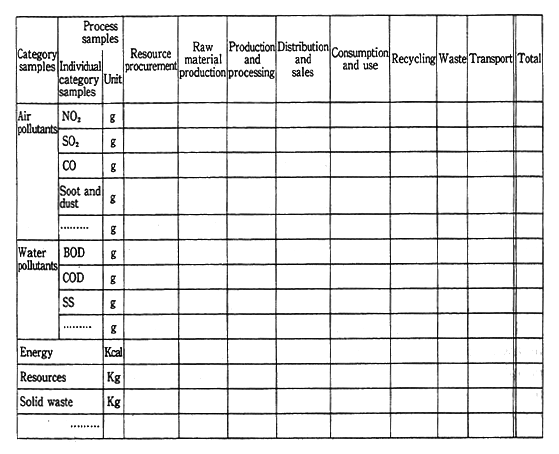
Source: Environment Agency
Fig. 2-3-5 Sample Analysis of Collected Data
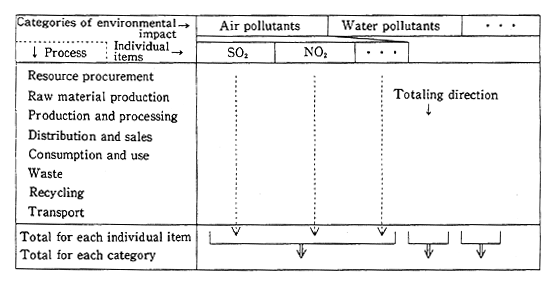
Source: Environment Agency
As previously stated, the ISO is also promoting the international standardization of LCA methods, which are expected to be adopted and broadly applied to concrete business activities as these methods become more clearly defined in the future.
Activities of Japanese Companies Operating Overseas
A large number of companies have set up operations offshore along with the development and maturing of the Japanese economy in recent years. Japanese companies, with their experience in achieving economic expansion while minimizing industrial pollution, have a broad understanding of the processes necessary for overcoming major industrial pollution problems. Developing nations, grappling with their own large-scale industrial pollution problems that have emerged along with brisk economic expansion, maintain a strong interest in the activities of their Japanese counterparts operating in their countries. Furthermore, as awareness of global environmental problems increases, the Japanese people are becoming more concerned about what Japanese corporations are doing overseas and expect companies to help preserve the environment in their theaters of operation. MITI's Industrial Structural Council, in its Expectations for Corporate Activities in Overseas Business Development report, provides guidelines on the environmental considerations required of Japanese companies operating overseas.
In fiscal 1992 the Environment Agency conducted a survey of Japanese companies operating in Thailand and Malaysia to gain a thorough understanding of environmental preservation initiatives by Japanese corporations in those countries. In fiscal 1993, a similar survey was undertaken in China, with 363 companies targeted for questioning and 13.5% responding. The results, which were issued in a midterm report, are as follows.
Of responding companies, 65.3% stated that they did not weigh environmental concerns when selecting a location for overseas operations. However, 40.8% of companies reported having undergone voluntary or mandatory environmental assessments when setting up their overseas operations (Figure 2-3-6). A total of 50% of the companies reported having altered their production planning or design processes or strengthened their environmental policies as a result of environmental assessments. Additionally, 42.9% of respondents did not undertake environmental assessments and 8.2% did not provide a clear response. It also must be noted that a number of companies initiated overseas operations under conditions not particularly conducive to improving environmental conditions.
Fig. 2-3-6 Companies Implementing Environmental Assessments When Setting Up Operations Overseas
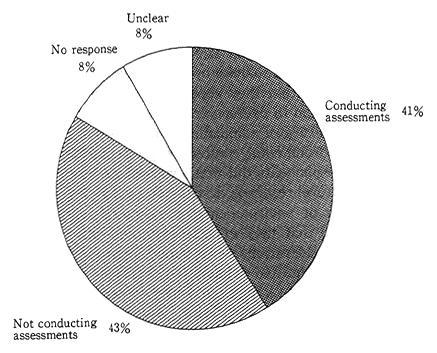
Source: Environment Agency
Fig. 2-3-7 Environmental Policy Goals
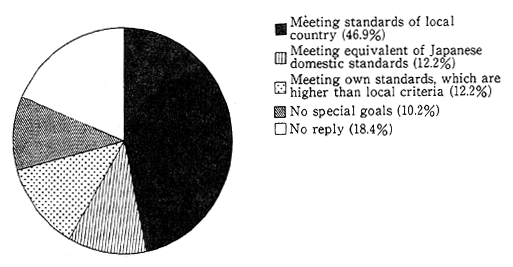
Source: Environment Agency
Furthermore, 46.9% of companies reported establishing environmental policy goals for their production operations based on local standards; 12.2% applied their own standards, which were more rigorous than local standards ; and 12.2% applied standards equivalent to those of their domestic Japanese operations (Figure 2-3-7). Also, 44.9% of companies stated that they appointed personnel within their local overseas organization to oversee or account for pollution-control measures. A total of 30.6% of companies responded that they did not take into account environmental matters when acquiring raw materials, while 8.8% of respondents did make such considerations-to prevent pollution and natural-resource destruction rather than to consider all potential aspects of environmental problems. Additionally, 8.8% of companies replied that they experienced some difficulty in weighing environmental considerations when purchasing raw materials, and 61. 8% of respondents admitted to having no particular concern for environmental matters. Thus, a clear majority of companies were either restricted in their ability to consider environmental problems when devising business policies or had no particular wish to do so. Nevertheless, many companies were able to properly account for environmental concerns when purchasing raw materials. The question of whether companies should take into account environmental issues as a whole when investing in developing countries was also posed. Companies replying that such considerations were appropriate for raising environmental protection capabilities in such countries totaled 22.4%. Furthermore, 10.2% of companies replied that such provisions were somewhat necessary, and 57.1% of respondents stated that they would consider this question when making such investments in the future. As to whether environment-related technology developed and advanced by Japanese companies had a potentially large market in developing countries, 44.9% of respondents believed that this was the case, and 12.2% stated that they had minimal expectations for growth in such a market. Many companies believed that the establishment of local operations by Japanese enterprises would be mutually beneficial to both sides.
Companies were also asked their opinions on promoting environmental policy in developing countries. Of companies answering questions about relations with local governments concerning environmental issues, some 80% reported no difficulty in following local government regulations and guidance on such matters, while 24.5% of respondents said that they experienced some problems in this regard. In comparing their own environmental-improvement measures with those of companies from other industrialized nations operating in the same developing regions, none of the respondents believed that the companies from other nations had more smoothly implemented environmental policy, while 26.5% of respondents indicated that their own measures were enacted as effectively or more effectively than those of their foreign counterparts. As to the relative cost of environment-related efforts, 49. 0% of companies replied that the financial burden of implementing such measures was currently light, but they were worried about the future as expenditures would increase in line with stricter regulations. A total of 8.2% of respondents stated that they had differences of opinion with local business partners regarding environmental matters, due to disagreements on the importance of environmental issues and other problems.
The survey clearly shows that Japanese companies operating overseas are confident that their endeavors to assist in improving local environments are fruitful and that they are making headway in promoting environmental activities with local partners. There is some concern, however, that environmental measures will become more burdensome in the future to reflect the policy initiatives of local governments. In response to a question on what policies should be put forward for further strengthening the environmental policies of local overseas subsidiaries and affiliates, some 80% of companies answered that such measures as enhancing support from local governments to these companies, raising environmental awareness among local citizens, and increasing the capabilities of local waste-processing companies and other enterprises performing environment-related services need to be promoted.
Community Assistance
Industry has an important role to play in contributing to and improving community life. As valuable members of society, businesses must work in the same manner as individual citizens to improve the community environment, and companies are increasingly recognizing the need to make the appropriate contributions to the regions where they operate. The Global Environmental Charter of the Federation of Economic Organizations (Keidanren), for example, stipulates that companies should undertake business activities that promote global environmental preservation in harmony with the surroundings, actively cooperate in such endeavors as members of local communities, and insist that employees also participate independently in such activities. According to a survey conducted by the Environment Agency in fiscal 1993 on environment-friendly business practices, 67.6% of responding companies are performing environment-related assistance activities in their communities, while 23.1% have established concrete goals for undertaking such actions (Figure 2-3-8). Amid growing demand for the cooperation of all citizens and businesses in building a socioeconomic structure capable of minimal environmental impact, companies must make even more diligent efforts in contributing to social well-being.
Fig. 2-3-8 Breakdown of Specific Goals
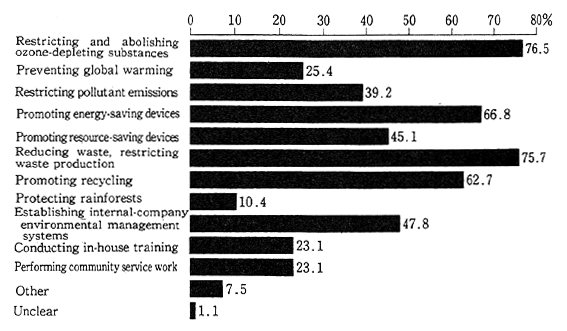
Source:Environment Agency
Expenditures for Environmental Preservation
A thorough understanding of expenditures related to the environmental preservation activities of corporations and businesses is important to ensure that such actions are truly effective. A clear grasp of how these expenses break down is essential for adopting effective policies and helping to reduce environmental preservation costs. Corporations focus on earnings, and it is generally believed that they avoid expending large amounts of financial resources on promoting environmental policies. Furthermore, due to the current recession, companies themselves insist that they do not have the additional funds to invest in environmental programs. In reality, however, according to the Environment Agency's fiscal 1993 survey on environment-friendly business practices mentioned previously, 29.7% of the 558 companies questioned do set aside resources for environmental expenses and investment, with expenditures restricted mainly to pollution-prevention and wastemanagement technology and equipment. It can therefore be concluded that the majority of companies are not clearly aware of the scope and range of possible expenditures for environmentally sound production processes and other advanced techniques that have improved the corporate earnings of many European and U. S. companies- In the survey, companies were asked their opinion on whether corporate expenditures on environmental preservation should follow defined rules based on criteria similar to those of other companies- While 85% of respondents answered this question in the affirmative, some 80% also believed that each company should make independent decisions based on individual circumstances, and gaining an understanding of the costs of complex corporate activities was difficult, somewhat dampening the desire to undertake such a task. Companies were also asked to comment on efforts to make information on corporate environmental-preservation expenditures available and on the movement in various nations to divulge such information on corporate environmental activities to the public. While a high percentage of respondents, 36.7%, thought that these were particularly good ideas and that Japanese companies should follow similar practices, an almost equal number of respondents, 34.9%, thought that individual businesses should exercise self-restraint and abide by impartial rules and regulations as much as possible in this regard (Figure 2-3-9). These survey results indicate a clear dichotomy at present between those companies having confidence in their own actions and working actively to disclose financial information and those corporations and businesses that do not wishing to be held to standards or judged on the amounts they spend on environmental preservation activities. Obviously business ventures and activities can be analyzed in an almost infinite number of ways, and making clear inferences about the scale or content of corporate expenses for environmental-preservation activities is an almost impossible task. By arriving at a clear understanding of where expenses toward environmental preservation are directed, however, cost-effective environmental policies, beneficial to both the internal workings of companies themselves and to society as a whole, can be implemented. Nevertheless, expense breakdowns indicate that many companies still fail to act independently and are incapable of making independent decisions in establishing environmental policy. Setting up resource accounting methods to investigate eco-related expenses on an international level is an important step, and such efforts are expected to reap benefits in the future.
Fig. 2-3-9 Disclosing Information on Environmental Preser vation Expenses
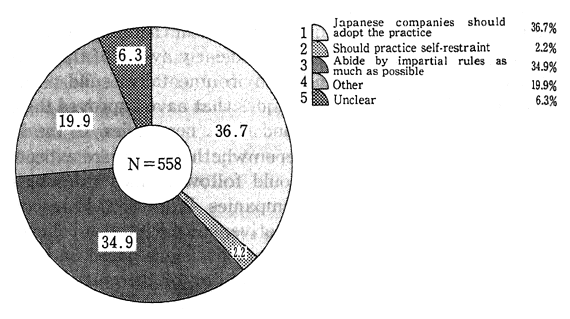
Source: Environment Agency
As noted previously, many of the corporate environmental themes of today will also be the issues of tomorrow. To answer the question of how companies should go about evaluating their own practices in dealing with environmental issues, the previously mentioned survey by the Socioeconomic Productivity Headquarters also took up the question of corporate self-evaluation of internal efforts to help solve global environmental problems. According to the survey, companies working actively or somewhat actively to undertake such appraisals totaled 15.6% and 421%, respectively, for a total of nearly 60%. In contrast, companies stating that they made minimal efforts or none at all in this regard were 30.1% and 4.3%, respectively, for a total of less than 40% (Figure 2-3-10).
Fig. 2-3-10 Corporate Self-Evaluation Regarding Environ mental Efforts
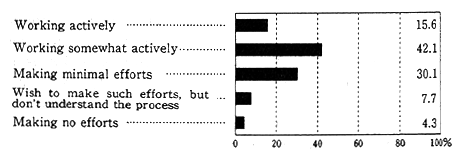
Source : Socioeconomic Productivity Headquarters
The survey also examined trends in corporate self-evaluation on the basis of capitalization. While over 70% of businesses capitalized at more than ¥1O billion undertook such evaluations, a large number of companies capitalized at less than this amount failed to do so. Because the majority of companies responding to the survey, 53%, were capitalized at less than ¥10 billion, the results thus indicate that more than half of businesses and corporations maintain a passive attitude toward instigating self-evaluation processes (Figure 2-3-11).
Fig. 2-3-11 Corporate Initiatives to Solve Environmental Problems (by Size of Capital by Reporting Com pany)
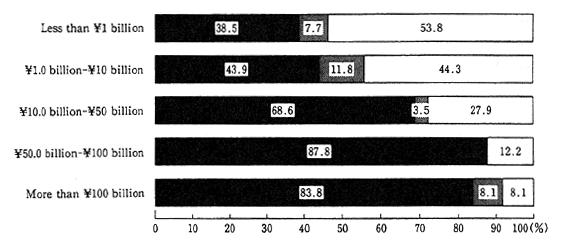
Source: Socioeconomic Productivity Headquarters
In addition, the Environment Agency's fiscal 1993 survey revealed that 39.8% of companies have established specific environmental improvement goals and 8.2% of companies planned to establish such goals in fiscal 1993, for a total of 48.0% working actively to achieve specific targets. A further breakdown by sales indicates that only a small percentage of companies with low sales turnover establish such goals (Figure 2-3-12).
Fig. 2-3-12 Corporate Establishment of Specific Environment Related Goals (by Size of Sales Turnover)

Source : Environment Agency
In Osaka, the metropolitan government conducted a survey of 1, 000 companies belonging to the Osaka Industrial Association on inhouse environmental-preservation systems in fiscal 1994. The response rate was 49.4%. According to the survey, 20.8% of companies have set up special organizations or offices or appointed supervisors to oversee environmental-preservation activities (Figure 2-3-13).
However, the Environment Agency's fiscal 1993 survey found that 63.3% of respondents had already established corporate structures to oversee environment-related activities and 2.0% planned to set up such structures in fiscal 1993, for a total of 65.3% maintaining some sort of organization to deal directly with environmental matters (Figure 2-3-14).
Fig. 2-3-13 Companies Maintaning In-House Environmental Preservation Systems
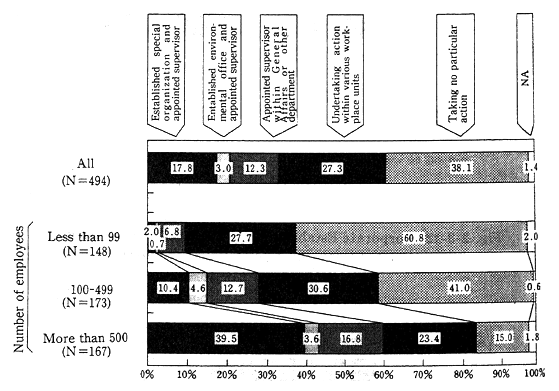
Source: Osaka City
Fig. 2-3-14 Existence of Corporate Structure Dealing With Environmental Matters
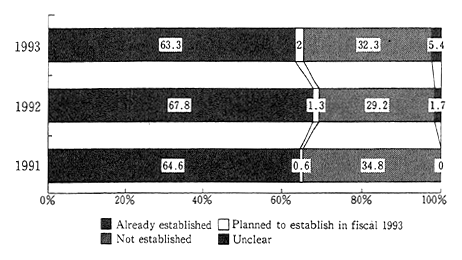
Source: Environment Agency
Fig. 2-3-14(2)Existence of Corporate Structures To Deal With Environmental Matters: Breakdown by Fiscal 1992 Sales

Source: Environment Agency
Neither Osaka metropolitan government nor the Environment Agency survey provided a breakdown of respondents by company type.The discrepancy in the results was due to the fact that 73.2% of responses to the Environment Agency survey, which targeted listed companies, were from businesses with more than 2,001 employees. In contrast, the Osaka survey focused on smaller business, with only 22.7% of responses from companies of more than 1,000 employees. These surveys clearly suggest that larger companies are making advances in implementing environmental-preservation policies, and the smaller the business, the more likely it is to take a passive posture toward environmental issues. Nevertheless, the active participation of manufacturers, distributors, waste-disposal companies, and all other corporate enterprises, both small and large, is needed to transform Japan into a sustainable socioeconomic entity with minimal environmental impact. Small and medium-sized enterprises in Japan, for example, employ approximately 80% of the work force, produce about 50% of manufacturing output on a consignment basis, and account for almost 80% of retail sales (Figure 2-3-15).
Fig. 2-3-15 Position of Small and Medium-Sized Enterprises in the Japanese Economy (Share)
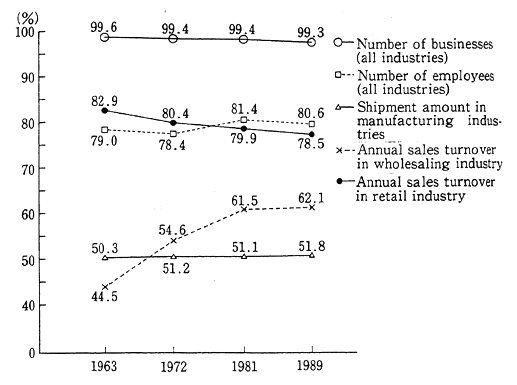
Source: Environment Agency, Statistics on Business, Report on the Effects of Changes in Business Locations, 1989 MITI, Statistical Charts on Industry, Statistical Charts on Commerce
Notes :1. Based, on number of establishments. Small and mediumsized establishments are defined as having fewer than 3OO employees (fewer than 100 in wholesaling industry and fewer than 50 in retail and service industries).
2. The shipment total in the manufacturing industies represents output fror establishments with more than 4 employees.
3. Employee numbers are provided for 196~3, 1972, 1981, and 1986. In the wholesaling and retailing industries, figures for annual sales turnover are calculated for 1964, 1972,1981, and 1988.
Thanks to their position of overriding importance in the Japanese economy, small and medium-sized enterprises wield considerable socioeconomic influence. Their efforts toward instigating environmental-preservation policies are therefore important. However, as has been illustrated, these smaller companies lag behind their larger counterparts in institutionalizing environmental-preservation practices, and government initiatives to spur such activities. The active participation of businesses of all sizes is necessary to build a sustainable socioeconomic structure with minimal environmental impact.
While the need for small and medium-sized enterprises to take independent action has been considered here, such activities are by no means beneficial only because they increase responsibility at the corporate level. In the United States, for example, companies have worked diligently in recent years to make their production processes more environment-friendly. Data provided by the U. S. Environmental Protection Agency based on case studies and in-depth analyses by a publicinterest research organization specializing in such conversion technologies illustrates this point. The economic effect of environmental reforms on individual companies was calculated based on a representative sample of 27 U. S. chemical plants of various types and sizes and a further 181 cases in which conversion to less environment-impacting production processes had recently begun. Companies were able to complete the preparation processes for such conversion within six months in two-thirds of cases, and capital outlays were not necessary in one-fourth of these instances. When capital investment was required, expenses were recovered within six months in two-thirds of the cases. The total profits from 62 of these recorded cases, taking into account savings compared to previous expenses and other factors, were $21 million, or approximately ¥2.2 billion, annually.
When taking any sort of general steps to reduce the environmental impact of their business activities, companies commonly implement a succession of comparatively cost-effective measures. Hence, there is a tendency to adopt policies with early short-term payoffs. Even allowing for this point, the economic advantages of the above cases figure prominently. Generally, corporate activities aimed at eliminating adverse environmental impact from the very early stages have wideranging economic benefits. First, costs associated with the disposal of waste are usually reduced from the outset by between 50% and 80%, according to preliminary studies. Second, improvements in sanitary conditions and the reduction of problems and dangers associated with pollution of the work environment depresses the various expenses stemming from these factors. Third, investment in new production processes generally leads to lower raw material needs and savings on raw material costs. Furthermore, from a long-term perspective, while reaping the financial benefits, companies with environment-friendly business practices and products gain consumer support and can expect increased sales.
As suggested by the preliminary U.S. study, environmental policy is not merely a responsibility for individual companies, but it often leads to improved performance and profits by providing the opportunity to eliminate wasteful practices and save on waste disposal and raw material costs. Despite the obvious rationale for implementing environment-friendly policies, however, many companies still fail to do so. As this chapter clearly indicated, many companies have unconsciously taken a conservative posture toward instigating environmental policy and, while consumers are pushing companies to take action, many enterprises are not adequately prepared to deal with the environmental problems affecting their communities. It will be necessary to overcome these obstacles to build a sustainable socioeconomic structure with minimal environmental impact, and companies must redouble their own efforts to, advance environment-friendly policies.
Chapter 3. The Challenge for Japan in Creating a Sustainable Socioeconomic Structure
In Chapters 1 and 2, we explored the effects of individual lifestyles and company behavior on the environment and presented ways in which environmental problems could be solve. But what role should the Japanese government play? This chapter addresses the challenge for Japan in building a sustainable society, mainly from the standpoint of government initiatives. In today's international community, which is characterized by a high level of mutual dependence, it is extremely difficult for a single country to establish a sustainable society by itself. Therefore, it is first necessary to grasp what the international community's expectations of Japan are and how it is contributing. To better understand Japan's position, we will draw on the OECD Environmental Performance Review, which provides a good example of evaluations of Japan's environmental policies by the international community, and the National Action Plan for Agenda 21, which outlines Japanese resolutions for realizing global environmental preservation through sustainable development to the international community.
Solving current environmental problems through only conventional regulatory measures is becoming increasingly difficult. The need has arisen to devise comprehensive and systematic ways of dealing with environmental problems, and movements are in progress to integrate environmental and economic policies at the international level. It is therefore necessary to consider government policies concerning environmental and economic integration. In Japan, the government has prepared the Basic Environment Plan and is promoting a number of comprehensive and systematic policies with a view to building a sustainable society with minimal environmental load for the 21st century. Here we provide an overview of these policies and then briefly discuss various economic measures in the Basic Environment Law and international trends that are expected to be effective in overcoming obstacles to environmental preservation. In addition, the establishment of comprehensive appraisal methods for discerning the relationship between the environment and the economy seem to be extremely effective, because it contributes to the creation of concrete measures for building a sustainable society with minimal environmental load and abundant blessing of the environment. Therefore, we are attempting to understand the basic ways of thinking and the international state of environmental resource accounting.
In this chapter, attention is also focused on the environmental policies of local governments and new environmental initiatives.
3-1 The Expectations of the International Community and Japan's Contributions to Environmental Preservation
3-1-1 The OECD Environmental Performance Review
As noted in the Preface, economic and social developments in Japan have become a major factor affecting worldwide environmental conditions. In view of this, what roles should Japan's environmental policy play? To help answer this question, we will examine the Envi. ronmental Performance Review dealing with Japan that was undertaken by the OECD Environmental Policy Committee in November 1993. These reviews, which were initiated through an agreement made at a January 1991 meeting of the OECD environment ministers, are one of the main activities of the OECD Environmental Policy Committee. The purpose of the reviews is to assess the degree of achievement of domestic objectives and of international commitments of reviewed countries, evaluate the results of these countries' practices, and clarify subjects for further attention. In concrete terms, a mission including OECD secretariat members and experts from examining countries visits reviewed countries, conducts investigations, and examines results at meetings of the Group on Environmental Performance, and after the above-mentioned process a final report is compiled. To conduct periodic environmental policy initiative reviews of member countries since 1994, pilot reviews were undertaken to achieve the previously stated goals and to establish the validity of the review methods themselves. These reviews covered Japan, Germany, Australia, Norway, and Portugal and took place in 1992 and 1993. Japanese environmental policy initiatives and achievements had already been reviewed by the OECD Environmental Committee (predecessor to the Environmental Policy Committee) in 1976 and 1977. The latest review was conducted in April 1993 by members of the OECD secretariat and experts from examining countries:Canada, Germany, New Zealand, and the Netherlands. This review group conducted hearings on environmental policy in a number of different areas with 13 ministries and government agencies, local governments and public bodies, representatives of industry, labor unions, and NGOs.
The report on the review consists of four main parts. The first part covers pollution control measures and natural resource management, the second policy integration, and the third cooperation with the international community. The fourth part presents the overall summary and conclusions of the review.
We first summarize the report and then provide an outline of policy initiatives undertaken in response.
(1) Reducing the Pollution Burden
a. OECD Assessment
It is highly estimated that over the past 20 years Japan has had the largest economic growth among industrialized countries while making considerable progress in solving problems related to air and water pollution and the handling of wastes. The decoupling of economic growth and expansion in emissions of such industrial wastes as SOx and NOx was achieved through economic structural changes, increased energy efficiency, and effective environmental policies. These successes have proved that environmental po1icies and economic development can be mutually supportive. b. Items Indicated by the OECD and Japanese Policies
(a) Concerning air pollution, the OECD Environmental Performance Review indicated among other matters (1) that strategic policies similar to those for NOx need to be applied also to SPM and oxidants, and (2) that consideration should be given to monitoring the discharge of benzene and other carcinogens, dioxins, heavy metals, and toxic substances into the atmosphere.
In response to these recommendations, comprehensive studies that include the examination of secondary particles are necessary in Japan to complement previously implemented policies on primary suspended particulate matter. In fiscal 1994, a five-year program entitled Coordinated Policy Studies and Investigation of Suspended Particle Matter was inaugurated.
Prompted by a pressing need to rapidly reduce particle matter from diesel exhaust, a five-year program was started in fiscal 1994 entitled Comprehensive Investigation for Reducing Diesel Exhaust Particles.
In addition, monitoring systems have been introduced for ongoing surveillance of atmospheric levels of dioxins, organic chlorine-based solvents, and other toxic substances. To deal with the many other substances that may pollute the atmosphere, we plan to prioritize these substances and undertake systematic initiatives, including expanded monitoring, to address these other causes of air pollution.
(b) Concerning waste management, we need to examine ways to (1) raise awareness of disposal costs among producers and consumers through effective use of economic instruments, (2) monitor soil pollution and leaks from landfill sites, (3) ensure proper disposal of hospital waste, and (4) reduce the volume of waste through long-term strategies for technology innovation and public education.
In Japan, relevant ministries and government agencies are pursuing studies on the effective application of economic and other instruments.
(c) Concerning water quality, it will be necessary to allocate a part of Japan's economic stimulus packages to water pollution control infrastructure. In addition, other necessary measures will include launching new programs concerning advanced wastewater treatment plants and establishing targets for the total loading of water bodies. Furthermore, for broader water pollution management programs, it will also be necessary to combat pollution from diverse sources and to enhance financial means for water pollution control, including increased use of charges for wastewater collection and treatment.
In response to items indicated in the OECD report, regulations for preventing water quality deterioration due to the drainage of toxic substances and pesticides in rivers, lakes, and marshes will be promoted. We will also work to establish a water surveillance and measurement system while continuing to pursue policies on community drainage that focus on improving the quality of small and medium-sized rivers, lakes, and marshes in urban areas. Specifically, in view of the importance of maintaining water quality at its source to guarantee safe and highquality water for public use, we will especially promote the necessary schemes under the guidance of the Extraordinary Measures For Water Quality Preservation at Public-Use Resource Sites Through Specific Prevention of Waterworks Irrigation and the Law for Promotion of Activities to Preserve Water Quality at Public-Use Water Sources. Toward these same ends, we will instigate various policies aimed at enhancing and strengthening the means of preventing water pollution due to the drainage of agrochemicals and waste by monitoring water quality in accordance with the Agricultural Chemicals Regulation Law and by establishing standards for measuring the safety of water sources. In addition, we will promote forest maintenance and planning under the guidance of the Special Forest Maintenance Measures. For the preservation of seawater quality, we will regulate nitrogen and phosphorous emissions, the cause of eutrophication; establish environmental safety standards for seawater; promote comprehensive policy coordination between relevant ministries and government agencies ; and determine ways of regulating water use. Moreover, from the perspective of preserving local ecosystems, we will examine technical measures for restoring tidelands and algae fields bordering the Seto Inland Sea ; study the impact of gravel extraction on local ecosystems and marine environments; and undertake surveys and advanced studies aimed at establishing environmental yardsticks for monitoring the quality of aquatic life and the viability of ecosystems.
(2) Quality of Life
a. OECD Assessment
Japan was given a high appraisal for significant improvement especially in promoting the protection of endangered species.
b. Items Indicated by the OECD and Japanese Policies
(a) Concerning nature conservation, economic growth and urbanization continue to place heavy pressures on the natural environment, and, as a result, there is a gap between realities and policy objectives. Therefore, the preparation of a national nature conservation strategy through the cooperative efforts of all relevant ministries and government agencies, local governments, and citizen groups is called for.
With the aim of preserving a biodiversity, investigations are being expanded into the nature of species diversification while studies are being promoted on ways of creating preservation areas for the future and developing networks for habitation and breeding environments. In addition, we will promote the designation and management of habitat preservation areas under the guidance of the Law for the Conservation of Endangered Species of Wild Fauna and Flora and revise this Law by expanding regulations on the transfer of rare endangered species to include even a part individual animals. To make wilderness areas more accessible, we will provide more public rest rooms in national and quasinational park areas; set up long-stay campgrounds and other amenities; work to train nature guides and volunteers; and undertake other activities that promote human contact with the natural environment.
(b) Regarding urban amenities, significant progress has been made. However, strong private land use rights and pressures from development due to economic growth have hindered improvement of urban amenities. To deal with this situation, attempts have been made to improve zoning systems and to implement regulatory measures effectively. Therefore, (1) integrated and coordinated implementation of various sectoral policies relating to amenities should be developed ; (2) local governments should take the initiatives to design and implement a comprehensive amenity policy ; (3) economic instruments (e.g., charges, user fees, and local taxes) should be considered in order to improve amenities and contribute to their funding; (4) existing zoning and other regulatory measures should be applied effectively to help preserve the environment from undesirable development; (5) remaining natural parts of urban and peri-urban areas should be protected more effectively; and (6) amenity concerns should be integrated in land use planning, economic plans, and comprehensive plans. Also, redistribution of the excessive concentration of activities in the Tokyo metropolitan area should be of concern.
In accordance with the need to facilitate a pleasant environment as well as encourage regional efforts, we will pursue policies that promote natural beauty and curb noise pollution in residential areas.
(c) Increased per capita income and leisure time have led to a large rise in the consumption of natural resources, causing higher levels of waste production and pollution. In view of these facts, the report pointed out the the need to adopt environment-friendly consumption patterns and lifestyles. The importance of environment-friendly consumption patterns and lifestyles was discussed in Chapter One.
(3) Integrating Environmental and Economic Decision Making
a. OECD Assessment
There is much room for improvement in integrating environmental concerns into other sectoral decision making in Japan as well as in other OECD countries.
b. Items Indicated by the OECD and Japanese Policies
(a) The OECD proposed the following measures for integrating environmental and economic decision making:
(1) A comprehensive environmental plan should be established under the cooperation of all ministries and government agencies concerned with environmental problems.
(2) Environmental impact assessment (EIA) procedures should be used more systematically and thoroughly, and be mandatory for all major projects.
(3) The public should be given access to environmental information and data; exceptions to this general principle should be limited to defined circumstances.
(4) Land use planning and regulations should be used more effectively.
We will promote the establishment of the Basic Environmental Plan as a means of indicating comprehensive and schematic fundamental measures that all government entities in Japan should take to build a sustainable society with minimal environmental load in the 21st century (refer to Chapter 2).
Regarding environmental impact assessment systems, we will conduct a study with the active participation of all the ministries and agencies concerned, on the situation concerning the implementation of EIA systems both in Japan and abroad and consider, based on the study, appropriately reviewing the present system, including the possibility of legislation, while taking into consideration such factors as socioeconomic changes. Also, we plan to promote comprehensive studies on both the systems themselves and the factors influencing environmental impact assessment at national and local governments and their counterparts in foreign countries. Concerning the provision of information about the environment, we are compiling relevant materials from Japan and abroad as well as actively working to supply general information through white papers on the environment, various educational pamphlets, and other means. In addition, at the Environmental Information Center in the National Institute for Environmental Studies, under the administration of the Environment Agency, guidance to information sources for acquiring environmental preservation data is prepared and provided for the public. The center also works to expand general knowledge and diffuse environmental information through guidance material (printed matter and electronic media).
(b) The following policies were deemed desirable from an economic point of view :
(1) To review the cost-effectiveness of current policies, and to employ cost-benefit analysis, particularly for public projects.
(2) To make greater use of economic instruments, such as fees, taxes, charges, and deposit-refund systems, after appropriate analysis and consultation.
(3) To review any financial assistance schemes to stimulate pollution abatement and control, with a view to assessing their environmental and economic effectiveness as well as their compatibility with the polluterpays principles.
(4) To examine pricing policies and fee structures that might lead to overuse.
According to the Environment Agency's calculations detailed in Chapter 2, there is no direct correlation between the economic influence of environmental preservation policies and the impact of these policies on employment in the long-term. In the - short-term, however, some influence may be seen, particularly in the construction sector. The importance of the effective application of economic instruments is generally recognized in Japan, and we are proceeding with investigative research in this area.
(c) According to the OECD Environmental Performance Review, the increase in the number of automobiles is a particular cause of air and noise pollution in urban areas. To address these problems, the possibilities of further improving public transportation facilities and utilizing various incentives and decentives should be considered ; measures to control NOx and particulate matter pollution from diesel vehicles should be strengthened; and a comprehensive transport development plan should be drawn up.
In response, we have decided to collectively and systematically pursue schemes to reduce NOx-through coordinated efforts of ministries and agencies concerned, and local governments-by promoting various regulations on vehicle types and policies on distribution and traffic control that incorporate basic gross-weight reduction measures and programs in accordance with the Extraordinary Measures to Reduce Gross Weight in Specified Areas of Nitrogen Oxides From Automobile Emissions. In addition, to reduce emissions of suspended -particle matter, we will conduct studies on comprehensive reduction policies and work to gain an understanding of pollution caused by diesel emissions into the atmosphere and the nature of exhaust particles themselves.
Furthermore, we will assist in introducing environment-friendly vehicles to local governments and pioneer the provision of low-pollution vehicles to public agencies while encouraging the widespread use of such automobiles and trucks by the private sector. Additionally, we will work to gain an understanding and conduct investigations of air pollution caused by aircraft exhaust emissions.
(4) International Issues
a. In dealing with the problems associated with climate change, Japan was able to decouple economic growth and CO2 emissions by promoting changes in the structure of its economy (by promoting energy conservation). However, the report indicated that as a result of the recent yen appreciation and low oil prices, the promotion of energy conservation incentives has declined and energy efficiency programs have slowed. Therefore, consideration of the following was suggested for the future. (1) The administration should further integrate its action on the climate change issues and promote the Action Programme to Arrest Global Warming, particularly in transport, building, and agriculture. (2) Long-term changes in technology and shifts in production and consumption patterns should be set out. (3) Incentives should be provided for the use of fuel efficient, lower CO2 emitting passenger cars, commercial vehicles, public transportation equipment, and ships. (4) Efforts should continue to sustain a high level of energy efficiency and to encourage further improvement. (5) Energy pricing and taxation systems should be examined to ensure that they are not undermining measures to prevent climate change. (6) Comprehensive policy instruments should be reviewed, including economic instruments, regulations, voluntary agreements, and education. b. In addition, the report indicated that although Japan has generally received high acclaim for its international contributions in a range of ecological fields, further examination of the following is required. (a) Regional cooperation in environmental fields (b) Ongoing initiatives related to the agreements established at the Earth Summit (specifically, those directed toward the environmental impact assessment of overseas projects and the supply of information on environmental risk arising from Japan's overseas activities, support for rainforest management, etc.)
(c) The adjustment of environmental ODA to levels appropriate to Japan's international position and in line with its share of global GDP.
We would like to place specific emphasis on the National Action Plan for Agenda 21, which was agreed on at a cabinet meeting on global environmental preservation in December 1993 and represents Japan's international pledge to help solve global environmental problems.
Table 3-1-1 Outline of the OECD Environmental Performance Review
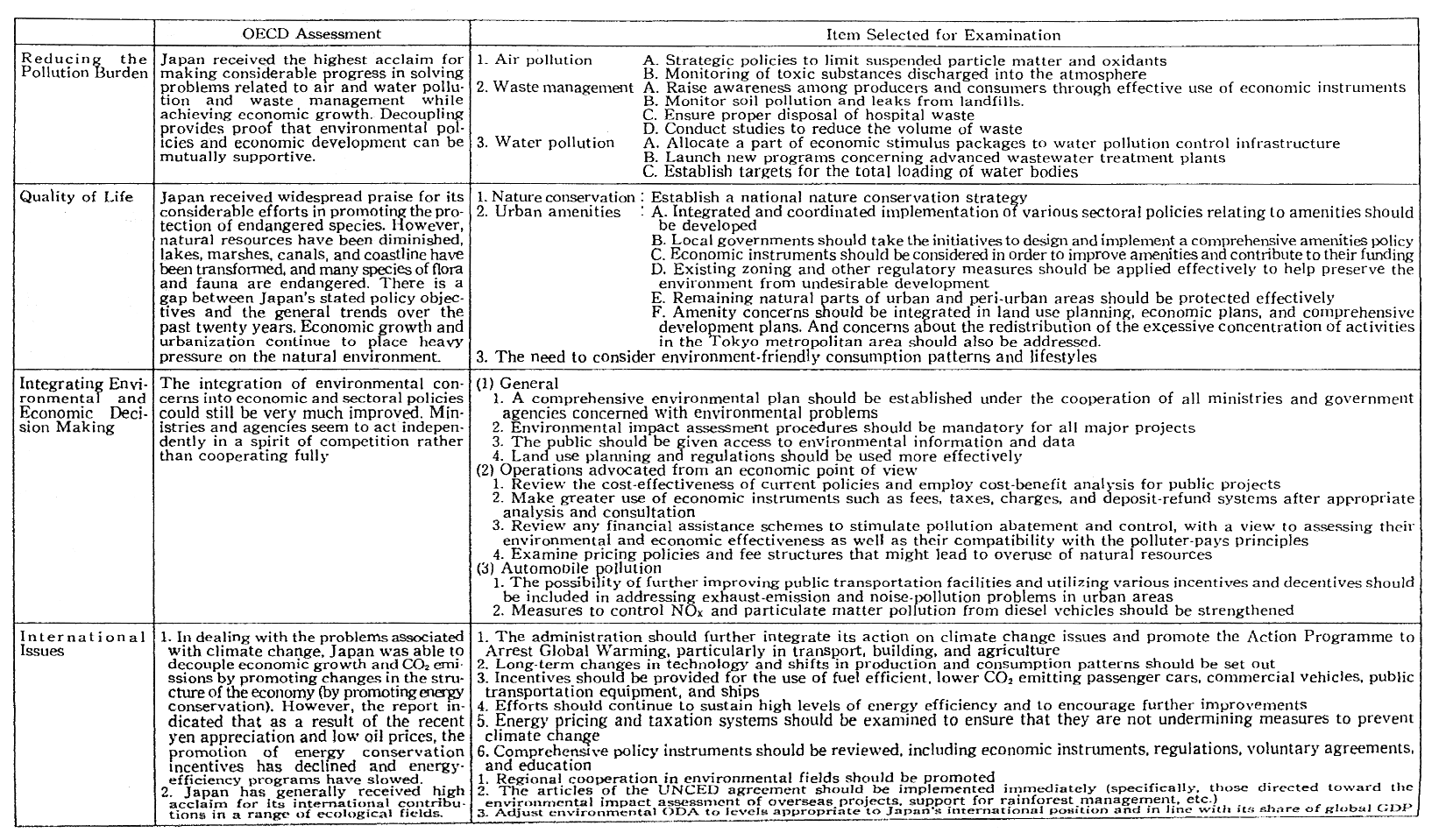
3-1-2 Global Trends and Japanese Contributions through Agenda 21
Agenda 21, a concrete action plan aimed at realizing sustainable development in the 21st century, was adopted at the UN World Conference on Environment and Development (Earth Summit), held in Brazil in June 1992. Chapter 38 of Agenda 21 requires that individual countries undertake studies and make preparations to achieve the plan. At the 1992 Munich Summit and the 1993 Tokyo Summit, the seven largest industrialized countries agreed to devise and make public action plans for the individual nations by the end of 1993. In Japan, work on a draft began in February 1992, through the cooperation of the Environmental Agency, the Ministry of Foreign Affairs, and other relevant ministries and government agencies. To build a social structure capable of sustainable development, the government encouraged the participation of as many citizens as possible while actively soliciting the advice of NGOs on how to respect the spirit of Agenda 21 and listened to wide-ranging opinions regarding the action plan. After completing and issuing a first draft, the government appealed for further opinions during the following three weeks. These efforts yielded hundreds of responses from more than 100 individuals and groups, including some 50 organizations. Government departments took up further study based on these responses and made appropriate revisions. The National Action Plan for Agenda 21 was agreed on at the Cabinet Ministers' Conference on Global Environmental Problems held on December 24, 1993, and the plan was submitted to the United Nations on December 28, 1993.
The National Action Plan for Agenda 21 is a document on how Japan is to challenge the various problems described in Agenda 21. These problems include such environmental issues as protection of the atmosphere and combating desertification as well as broader subjects such as eradication of poverty and population. Through this plan, the country is demonstrating to the international community Japan's resolve to promote global environmental preservation through sustainable development. In concrete terms, we described planning, legal, budgetary, and other policies addressing specific problems. The structure of the plan, in accordance with Chapter 40 of Agenda 21, is separated into four sections: I. social and economic dimensions, II. conservation and management of resources for developing, III. the strengthening of the roles of major groups, and IV. means of implementation. The special characteristic of the Japanese plan is that the plan aims to change Japan's own socioeconomic structure to a sustainable society that generates little burden on the environment in line with the Basic Environmental Law formulated in November 1993. The plan also advocates actively working to lead the way in international environmental and developmental cooperation by utilizing Japan's experiences and technologies and promoting environmental ODA appropriate to its position in the global society. The following is the survey of world trends and Japanese activities for global environment conservation (refer to National Action Plan for Agenda 21).
(1) Making Efforts to Construct a Society Which Will Allow Sustainable Development with Reduced Load on the Global Environment and Enhance Public Awareness in Order to Change People's Lifestyles to Ones Which Are More Environment Friendly
For these activities, it is important to review previous production and consumption patterns, examine wasteful practices in the community, pursue environmentally sound economic development with appropriate revisions, and emphasize building a sustainable socioeconomic structure with minimal environmental loads. Thus, it is necessary to consider environmental issues when pursuing all socioeconomic activities. First, it is essential to build a sustainable social structure by implementing the Basic Environmental Plan, which details comprehensive long-term policy principles related to environmental conservation, and by advocating the effective use of regulatory and economic measures, environmental impact assessment, and gaining the cooperation of business and the public in supporting and pursuing other diverse measures.
In addition, as was discussed in Chapter 1, the government recognizes the need for spreading information and promoting education to create lifestyles in which citizens are concerned about the environment and act accordingly.
(2) Participating in and Contributing to the Development of an Effective International Framework for the Conservation of the Global Environment
The Environment Agency will make the best use of Japan's capabilities to contribute toward improving cooperation with other nations for conserving the global environment commensurate with Japan's place in the international community. The following is a general overview of Japan's efforts to conserve the global environment, as written in the National Action Plan for Agenda 21. Current conditions in the global environment will be argued in Chapter 4.
a. Steady Follow-Up of the Results of the Earth Summit (UNCED)
The Commission on Sustainable Development (CSD), the body established specifically to follow-up the results of the Earth Summit under the administration of the U.N. Economic and Social Council (ECOSOC), held its first meeting in June 1993. The United Nations plans to hold a special conference on the environment and development in 1997 as a follow-up to the Earth Summit. The CSD is dividing the chapters of Agenda 21 according to various themes and will review relevant initiatives every year leading to 1997. The passing of the National Action Plan for Agenda 21 is one important contribution to CSD (Chapter 38).
b. Global Warming
In addition to activities supporting the Intergovernmental Panel on Climate Change (IPCC) related to global warming, we will promote the systematic and comprehensive application of policies as outlined in the Action Program to Arrest Global Warming under the guidance of the U. N. Framework Convention on Climate Change (Chapter 9B).
(1) As part of Japan's efforts to arrest global warming, the Action Program to Arrest Global Warming was agreed on at the Council of Ministers for Global Environment Conservation held in October 1990. A wide range of policies are being implemented in line with the plan.
With the goal of controlling CO2 emissions, the government is steadily implementing a wide range of measures under the Action Program through utmost efforts by both the government and the private sector. We intend to stabilize CO2 emissions on a per capita basis in the year 2000 at about the same level as in 1990. Moreover, in line with the goals above, we will make concerted efforts to stabilize the total amount of CO2 emissions in the year 2000 at about the same level as in 1990 through progress in the development of innovative technologies, etc., including those related to solar, hydrogen, and other new energy and fixation of CO2 at the pace and in the scale greater than currently predicted. Moreover, we are working to establish a wide range of policies covering scientific research, monitoring and observation, technological development and its dissemination to promote public awareness, and international cooperation in controlling emission of CO2, methane, and other greenhouse gases as well as promoting research into CO2 absorbents in forests. These activities will be undertaken in the 20-year period from 1991 to 2010.
(2) Studies by the IPCC
In November 1988, the IPCC was established under the joint sponsorship of the World Meteorological Organization (WMO) and the United Nations Environment Programme (UNEP). The panel sponsors studies by scientific bodies, government agencies, and other organizations throughout the world to study scientific findings on global warming, environmental and socioeconomic impacts, and response strategies. The IPCC compiled its first assessment report in August 1990 and presented a supplementary report in February 1992. This gathering of scientific knowledge on global warming is extremely beneficial and has contributed significantly to advancing negotiations on the Framework Convention on Climatic Change. The IPCC is currently gathering materials for its second assessment report, to be issued at the end of 1995.
(3) The Framework Convention on Climatic Change
The Intergovernmental Negotiating Committee was established by the General Assembly at its 45th session, and the convention drawn up by the committee was adopted in May 1992. Japan was one of the 155 parties to sign the convention during the Earth Summit in June 1992. Japan ratified the convention on May 28, 1993, becoming the 21st contracting party. On December 21, 1993, the number of contracting parties reached the required number of fifty, and the convention went into effect on March 21, 1994. The ultimate objective of the convention is to stabilize concentration of greenhouse gases in the atmosphere. The industrialized nations, in line with their convention obligation to return greenhouse gas emission levels to previous levels by the end of the 1990s, have been required to forward information on government policies, measure and estimate their effectiveness, and to provide funding and technological support to developing countries. Even though the convention has been adopted, negotiations are continuing to ensure its smooth execution, and studies are being conducted to determine whether commitment to the current convention is appropriate or not. And, the studies of yardsticks for joint implementation by the contracting parties and guidelines for the first forwarding of information are also being conducted.
c. Conservation on Biological Diversity
The Convention on International Trade in Endangered Species of Wild Fauna and Flora (CITES), the Convention on Wetlands of International Importance Especially as Waterfowl Habitats (Ramsar Convention), and other treaties had addressed specific issues such as regulation of international trade in wildlife species and the preservation of wetlands, so the Convention on Biological Diversity was adopted in May 1992 at the 7th negotiating committee meeting in Nairobi with a view to widening the framework of wildlife protection policies and to setting a comprehensive international framework for the conservation of biological diversity and the sustainable use of biological resources. In June 1992, 157 nations including Japan signed it during the Earth Summit. In addition, Japan ratified the convention on May 28, 1993, and it went into force on December 29, 1993. The convention aimed at conserving biodiversity at the level of ecosystems, species, and genes, sustainable use, and equitable distribution of biological resources. Toward these ends, the convention establishes mechanisms for setting national strategies, specifying and monitoring key species and ecosystems, conducting research and training, and establishing protection areas. On April 1, 1993, the Law for the Conservation of Endangered Species of Wild Fauna and Flora became effective. It plans to effectively utilize the existing legal system and other means to promote nature conservation. In the Basic Environment Law, conservation of biodiversity acts as one means of establishing and enforcing environmental protection policies. Additionally, in-January 1994, a liaison commission composed of representatives of nine relevant ministries and government agencies was formed for the purpose of smoothly promoting enforcement of the Convention on Biological Diversity. By promoting biodiversity through the gathering and provision of primary data compiled by the National Survey on the Natural Environment, establishing strategies and action plans at the national level from the perspective of maintaining sustainable use, and promoting international cooperation in ensuring species diversification, the National Action Plan for Agenda 21 serves as an effective mechanism within the international framework of the Convention on Biological Diversity.
d. Conservation of Tropical Rainforest
The International Tropical Timber Organization (ITTO), inaugurated in 1985, held its 15th board of directors' meeting at its Yokohama headquarters in November 1993. Representatives from 17 tropical timber producing nations, including Malaysia, and 22 consumer nations, including the United States, as well as relevant international organizations and NGOs attended. ITTO's many projects include rainforest management, forest cultivation, and research on the potential applications of previously unused forest resources, and 200 projects are either completed, under way, or planned. As the International Tropical Timber Agreement (ITTA) was due to expire at the end of March 1994, negotiations to revise the agreement were held four times beginning in 1993, and a new agreement was adopted at a conference held in January 1994. While this new agreement is fundamentally the same as that of its predecessor, some content revisions have been made. These include clarifications of new agreements for Target by 2000, and the establishment of the Bali Partnership Foundation to achieve sustainable forest management of the tropical rainforests. Furthermore, the agreement calls for consumer countries possessing tropical or temperate rainforests to promote the sustainable management of their own forests and to achieve this objective by 2000.
Because the Japanese economy is deeply linked with the plight of forests on the earth, other nations worldwide are calling for Japan to make greater contributions to the conservation of forests. The country is undertaking various efforts to conserve tropical rainforests and other timberlands. In addition to contributing to the activities of the United Nations Food and Agricultural Organization (FAO), ITTO, and other international organizations at the government level, the government is collaborating with developing countries in cooperative ventures. Such joint operations as forest management, technological development for woodland creation, and others are being or have been carried out in developing countries in Southeast Asia, Oceania, Africa, Central America and South America, and they are achieving results. Japan's cooperation with individual nations in forest and forestry areas is fostered, it includes technological cooperation projects and joint development and surveys administered through the Japan International Cooperation Agency (JICA), loan assistance through the Overseas Economic Cooperation Fund (OECF), grant aid, etc. The National Action Plan for Agenda 21 aims to foster trust between industrialized and developing countries, strengthen international cooperation in promoting sustainable forest management, and improve the collaborative capabilities of the many countries involved in this area through ITTO and other organizations (Chapter l1E).
e. Toxic Chemicals
Promoting the proper control of toxic chemicals at the international level has become a pressing issue. UNEP adopted the London Guidelines for the Exchange of Information on Chemicals in International Trade in 1987, and these guidelines were revised in 1989. The London Guidelines provide for the international exchange of information on regulatory measures and import and export conditions in each country. In order that banned and severely restricted chemicals might not be exported against importing countries' will, they also call for the establishment of the Prior Informed Consent system and the Export Report System whereby relevant information is supplied beforehand to importing countries.
The National Action Plan for Agenda 21 calls for active participation in safety assessment and other schemes conducted by the International Program on Chemical Safety (IPCS), the OECD, and other organizations as well as cooperation in promoting international control under the auspices of the London Guidelines for the Exchange of Information on Chemicals in International Trade (Chapter 19).
f. Transboundary Movement of Hazardous Wastes
There have been instances where Japanese concerns have been involved in the international trade of hazardous wastes for the purpose of collecting useful matter from such waste and for other purposes, Mainly under the auspices of UNEP, studies were conducted on drafting international rules for such transboundary movements of hazardous wastes. In March 1989, in Basel, Switzerland, the Basel Convention on the Control of Transboundary Movements of Hazardous Wastes and Their Disposal was adopted. The convention was entered into force on May 5, 1992. Japan became a convention member in September 1993, and the convention was entered into force in this country in December 1993. In addition, a domestic law, the Law for the Control of Export, Import and Others of Specified Hazardous Wastes and Other Wastes, was passed and implemented in December 1993.
Sincerely executing the Basel Convention is the duty of each contracting party, and it has been strongly suggested that as a significant step toward solving global environmental problems, one obligation of Japan is to assist Southeast Asian nations, in particular, through international cooperation. At the second meeting of the parties of the Basel Convention in March 1994, a consensus was reached to pass a resolution to immediately prohibit hazardous waste exports for the purpose of final disposal from OECD member countries to nonmember countries and prohibit hazardous waste which are to be recycled after 1998. Japan is requested to faithfully follow these resolutions. The National Action Plan for Agenda 21 calls for proper implementation of the relevant domestic laws and close ties with relevant countries and international organizations in line with the Basel Convention (Chapter 20).
g. Ozone Layer Protection
Measures are being implemented for international cooperation in protecting the ozone layer under the Vienna Convention for the Protection of the Ozone Layer (1985) and the Montreal Protocol on Substances that Deplete the Ozone Layer (1987). In Japan, to ensure the accurate and smooth implementation of the convention and the protocol, the Law Concerning the Protection of the Ozone Layer through the Control of Specified Substances and Other Measures (the Ozone Layer Protection Law) was enacted in 1988. This law regulates the production of chlorofluorocarbons (CFCs) and other chemicals ; controls their emissions; rationalizes their use by industries ; and provides for their monitoring and surveillance.
At the fourth meeting of the contracting parties of the Montreal Protocol held in November 1992, a revised protocol was adopted- It provided that the total abolishment of CFCs and other substances should be brought forward and control of hydrochlorofluorocarbons (HCFCs) and other newly regulated substances should be strengthened. In response, in May 1993, Japan amended the relevant proclamations to include the total abolishment of previously regulated substances and will revise the Ozone Layer Protection Law to include additional control for new regulated substances.
h. Desertification
The outbreak of drought in the Sahel area of Africa during the latter half of the 1960s and the 1970s provided an opportunity for the United Nations to begin efforts in this area. The United Nations Conference on Desertification (UNCOD) was held in 1977, and, based on the Plan of Action to Combat Desertification (PACD) that was adopted at this conference, work efforts were made mainly by UNEP. However, in spite of the efforts desertification is in progress. At the Earth Summit in June 1992, proposals were put forward by African nations with the view of establishing an intergovernmental negotiations committee for passing an international treaty on desertification (Agenda 21 Chapter 12), and in December 1992 the 47th session of the United Nations General Assembly adopted a resolution to establish the intergovernmental negotiations committee to draft a convention to combat desertification (INCD). In January 1993, an organizational session was held to make preparations for the negotiations. Japan is actively participating and working toward furthering future negotiations with the aim of completing the convention in June 1994. The nation must promote comprehensive international cooperation to solve the problem of desertification. The Environment Agency is striving to clarify the efforts being made by Japan and other industrialized nations to solve the desertification problem while conducting studies on ways to promote comprehensive desertification-prevention policies based on the convention and strengthening other efforts to deal with this issue. The National Action Plan for Agenda 21 calls for the promotion of investigative research on the reciprocal impact of human activities and desertification; the active and ongoing participation in the sessions of drawing up a convention to deal with this problem by June 1994 ; and assistance to local residents in their self-help efforts to solve the problem of desertification (Chapter 12).
i. Conservation of Marine Environment
In Japan, measures have been adopted to prevent marine pollution from land-based sources in accordance with the Water Pollution Control Law and to prevent marine pollution caused by ships and marine facilities in accordance with the Law Relating to the Prevention of Marine Pollution and Maritime Disaster. The National Action Plan for Agenda 21 calls for active participation in international initiatives through the Convention on the Prevention of Marine Pollution by Dumping of Wastes and Other Matter (London Gonvention), MARPOL 73/73, and other conventions. The Action Plan also promotes international cooperation and regulation, including collaboration on regional environmental policies with the International Maritime Organization (IMO), UNEP, and other international agencies (Chapter 17B, Chapter 20C, D).
j. Acid Rain
Acid rain is an environmental problem that affects wide areas and transcends national borders. Measures to combat this problem require the combined efforts of all the nations in a particular region. In Europe and North America, emphasis is being placed on addressing the sources of such nonlocal environmental problems as the acidation of lakes and marshes and the degeneration of forest areas. A monitoring network is being constructed in twenty European countries and the United States and Ganada, surveillance is proceeding, and information exchange and policy measures, including ratification of an agreement to reduce emissions of the substances causing acid rain, are being implemented based on the Convention on Long-Range Transboundary Air Pollution. The National Action Plan for Agenda 21 calls for promoting domestic investigation and research, developing a forecasting model of acid precipitation in the East Asian region and establishing an acid precipitation monitoring network in East Asia, and assisting in clarifying existing conditions and studying ways to implement such plans. (Ghapter 9D).
k. Trade and Environment
Japan with the United States, the European communities, and Canada played a role in accelerating discussions on trade and the environment at the Quadrilateral Trade Ministers' Meeting. The mutual supportiveness of the environment and trade policies can be made possible where environmental benefits and costs are internalized into prices. An open mutual trading system, supported by the adoption of sound environmental policies, would have a positive impact on the environment and contribute to sustainable development. In consideration of the above recognition, Japan has been actively participating in and contributing to mutual discussions in theOEGD and the GATT toward the establishment of mutual supportiveness of trade and the environment (Chapter 2B, the National Action Plan for Agenda 21).
(3) International Efforts for Financing Global Environmental Conservation and Environmental Conservation in Developing Countries
To effectively implement Agenda 21 on a global scale, efforts must be made to promote sustainable development in developing countries, and industrialized countries must support those efforts. Specifically, regarding financial support, Japan's assistance to developing countries through current two-party and multilateral mechanisms will be reviewed to ensure the provision of effective and efficient aid.
a. Environmental ODA
Japan expressed its goals for environmental ODA at the Arche Summit in 1989. At that time, a pledge to amplify and strengthen two-party and multilateral environmental ODA was announced, with the goal of providing ¥300 billion in aid over a three-year period beginning in 1989. This goal was surpassed, with ¥407.5 billion in aid being furnished.
At the Earth Summit, a policy of providing active cooperation to the International Development Association (IDA) and the Global Environmental Facility as well as supporting other multilateral collaboration was clarified, and Japan announced a policy of greatly expanding and fortifying its environmental ODA to a total of between ¥900 billion and ¥1 trillion over a five-year period beginning in 1992. Also in 1992, the cabinet adopted Japan's Official Development Assistance Charter, which recognizes as a central doctrine that environmental conservation is a human problem to be solved jointly by industrialized and developing countries and which emphasizes "working to achieve environmental conservation while making efforts to promote sustainable development worldwide." Achieving compatibility between environmental concerns and industrial development is being promoted as one of four principles of the charter, and, in line with this, aid has been pledged to assist in the endeavors of developing countries to solve environmental and other problems. It has now become a task to materialize these policies by establishing policy dialogue with developing countries and attempting to strengthen efforts to discover appropriate projects. In addition, Japan's ODA Charter calls for the effective use of technology and know-how that draw on Japan's own success both in promoting environmental conservation and in achieving economic growth as well as enhancing environmental cooperation through the Japan International Cooperation Agency engaged in such activities. Amid rising demand for subsidies --due to such factors as the growth in the number of global environmental problems and of countries adopting democratic governments and market economies--expanding the amount of aid and working to improve the quality of ODA have become important issues. Thus, in line with the targets expressed at the UNCED, the five-year plan for the 1993 through 1997 period, which was passed under strict financial conditions, pledged to direct between $70 billion and $75 billion toward ODA spending and, for environmental aid in particular, called for flexible cooperation in both reparation and non-reparation funding to support efforts by developing countries themselves to conserve the environment and achieve development.
Moreover, Chapter 2 Section 6 of the Basic Environment Law sets forth stipulations concerning international cooperation on global environmental conservation and other matters.
In addition, in providing Japanese ODA, it is only appropriate that environmental conservation in the place where the aid is directed be of prime importance. The government strengthened environmental considerations for the provision of ODA in an agreement passed at the Council of Ministers for Global Environment Conservation in 1989. The Overseas Economic Cooperation Fund (OECF), which supervises yendenominated aid, passed the OECF Guidelines for Environmental Considerations in October 1989 to ensure that the environment receives consideration in connection with financial matters. Furthermore, the Japan International Cooperation Agency (JICA) has passed the Guidelines for Environmental Impact Assessments Concerning Dam Construction in addition to environmental-consideration guidelines in other areas.
Additionally, Article 35, Item 1 of the Basic Environment Law stipulates that in pursuing international cooperation, Japan needs to take appropriate measures to ensure that obstacles to environmental conservation in a particular region do not arise as a result of overseas projects.
b. The Financial Cooperation Plan for Developing Countries
In June 1993, the Financial Cooperation Plan for Developing Countries was passed. Under this plan, financing will be provided to meet targets over the next five years by drawing on ODA funding as well as on untied loans by the Ex-Im Bank of Japan and other non-ODA sources. Furthermore, when financial assistance is provided through the OECF and the Ex-Im Bank, environment and infrastructure development will be given special emphasis. The Japanese government is also extending assistance to the World Bank and other international development and financial institutions as well as the IMF.
c. The Global Environmental Facility (GEF)
Because active efforts by developing countries are important in solving global environmental problems, GEF was inaugurated in 1991 on a trial basis as a multilateral financial cooperation mechanism to promote such efforts by developing countries. GEF is operated under the joint management of the World Bank, UNEP, and UNDP. Its activities are restricted to four areas: combating global warming, conserving the environment of international waters, conserving biological diversity, and protecting the ozone layer. The three-year trial program for GEF expired in June 1994, and, in accordance with an agreement made at the Earth Summit on GEF, discussions were held on new arrangements, finance levels, and other matters. A new agreement was signed at a meeting of member countries held in Geneva, Switzerland, in March 1994. Based on the success of the test program, the financing level for GEF was increased to approximately $2 billion. In consideration of Japan's international standing, Japan has announced funding of approximately $415 million, making it the largest donor after the United States.
(4) Improving the Environmental Conservation Capabilities of Developing Countries through Transfer of Environmentally Sound Technology and Other Means
To achieve sustainable development with minimal environmental load, it is essential to improve environmental conservation capabilities in developing countries. Therefore, the diffusion of pertinent technologies through access to the environmentally sound technology of industrialized countries is necessary. Furthermore, it is important to promote appropriate technology transfers as well as cultivate and improve the capability to receive such transfers through training and other means, particularly for countries lacking the capabilities to apply technologies.
Toward these ends, the UNEP International Environmental Technology Centre was established in October 1992 in Japan with the aim of advancing technology transfers of relevant environmental technologies to developing countries through database construction and management, training, consulting, and other services. Using this centre, Japan will promote the development of a database network of individual information systems containing environmentally sound technologies and knowledge gained from experience as well as contribute to the construction of an international technology network.
Furthermore, the Japanese government will continue to promote technological cooperation through JICA. Through centers set up with Japanese assistance in Thailand, Indonesia, and China, Japan will promote personnel training to assist in elevating the skills of these nations as well as pursue similar cooperative efforts in other developing countries. Moreover, in cooperation with. relevant ministries, government agencies, and local governments, JICA will organize group training on environmental issues for representatives of developing countries, dispatch Japanese experts to these nations, and, thus help improve the technological leadership and capabilities of developing countries to solve environmental problems.
(5) Maintaining International Cooperation in Monitoring and Surveillance and Investigative Research for Global Environmental Conservation
In order to promote sustainable development, it is necessary to inform policy makers, as well as the general public, of the range of the selection of measures which Japan might adopt in future, forecasting, from a long-term perspective, the effects which developments will have on society, the economy, and nature. And it is also necessary to promote a deeper understanding of complex ecosystems by advancing scientific research, monitoring, and surveillance, and to enhance knowledge of human activities and their impact on changes on the global environment. Toward these ends, the Japan will:
(1) actively participate from the planning stages in the International Geosphere-Biosphere Programme (IGBP), the World Climate Research Programme (WCRP), and other international investigative programs as well as in the IPCC and other scientific assessment activities while actively contributing to regional cooperation in constructing a research network in the Asia-Pacific region (Chapter 35A)
(2) promote research and development on earth observation technologies which are necessary for quickly amassing data on extensive expanses of the earth and for marine, land, and aerial observation, including an artificial satellite which can observe the earth on a wide scope in a short period of time (35B);
(3) contribute to the construction of a global system, incorporating such systems as the Global Climate Observing System (GCOS) and the Global Ocean Observing System (GOOS) and assist in worldwide monitoring and surveillance activities by participating and collaborating in international monitoring programs (Chapter 35B) ; and
(4) promote the processing and analyzing of data obtained through global observation, improve the database, and contribute toward the construction of an international network of earth observation related information (Chapter 35B,C,D).
(6) Strengthening Cooperation between the Central Government, Local Authorities, Businesses, and Non.-Governmental Organizations
Chapters 24 to 32 of the National Plan for Agenda 21 describes various groups' expectations for deepening understanding of environmental preservation within communities and the active promotion of independent efforts for building a sustainable society with minimal environmental load. First, the Japanese government will step up efforts to provide environmental education and supply pertinent information to all of these constituents and accelerate their participation in environmental preservation programs. On the other hand, Japan will support independent and autonomous initiatives on environmental preservation by local governments, including those involving international cooperation, through information supply and other means while working to enhance and strengthen support for the activities of NGOs in environmental areas through global environmental funds and other means. Furthermore, assistance will be provided so that the community can undertake independent initiatives and play its own respective role in pursuing environmental preservation activities.
Effort will be made to smoothly and effectively advance unified actions on the part of the government and these actions will be promoted based on decisions made at the Council of Ministers for Global Environment Conservation. In concrete terms, the Japanese government plans to advance measures for putting into effect the Basic Environment Plan in accordance with the provisions of the Basic Environment Law and to promote individual policies relating to the six items being stressed for consideration. The government will also revise the action plan when deemed necessary and make further efforts to build a sustainable society with minimal environmental load.
3-2 New Efforts to Link the Environment and the Economy
3-2-1 The Basic Environment Plan
The Basic Environment Law stipulates that environmental preservation should be comprehensively and systematically promoted and, central to this theme, the Basic Environment Plan should be implemented. The Basic Environment Plan will coordinate environmental preservation policies in a wide range of areas as determined by the Basic Environment Law; provide fundamental policy direction for all government agencies on the basis of fair apportionment of duties for all parties concerned; comprehensively and systematically promote such policies from a long-term perspective; and outline efforts expected of regional governments and public corporations, industry, and the public.
On January 14, 1994, the consultation of "How the Basic Environment Plan Should Be" was submitted by the Prime Minister to the Central Environment Council. The Central Environment Council plans to submit an interim report in the middle of 1994 and a final report in the latter part of the year.
The trend toward developing comprehensive environmental plans is emerging in other major industrialized countries as well as in Japan, especially as a result of the 1992 United Nations Conference on Environment and Development. Such plans have been implemented in Great Britain, Australia, the Netherlands, Canada, and France, as well as in the European Union. Outlines of these plans are presented in Table 3-2-1. In light of this trend toward establishing comprehensive environmental policies in these nations (and regions), sustainable development has become an important theme through the momentum of the Brundtland Report (Our Common Future). There is a growing recognition that broader and more far-reaching socioeconomic activities also have a negative environmental impact and that these areas need addressing. Thus, as a basic policy, most of these plans draw attention to pivotal issues in specific socioeconomic areas.
As stated in the conclusion of the OECD Environmental Performance Review of Japan, issued in November 1993, the establishment of a Comprehensive National Environmental Plan is the first step in integrating environmental and economic policies. The Basic Environment Plan is the principal means of considering the environment in conjunction with economic and other activities and ensuring equal burden-sharing by all major parties involved.
Table 3-2-1 Comprehensive Environmental Plans in Major Industrialized Countries
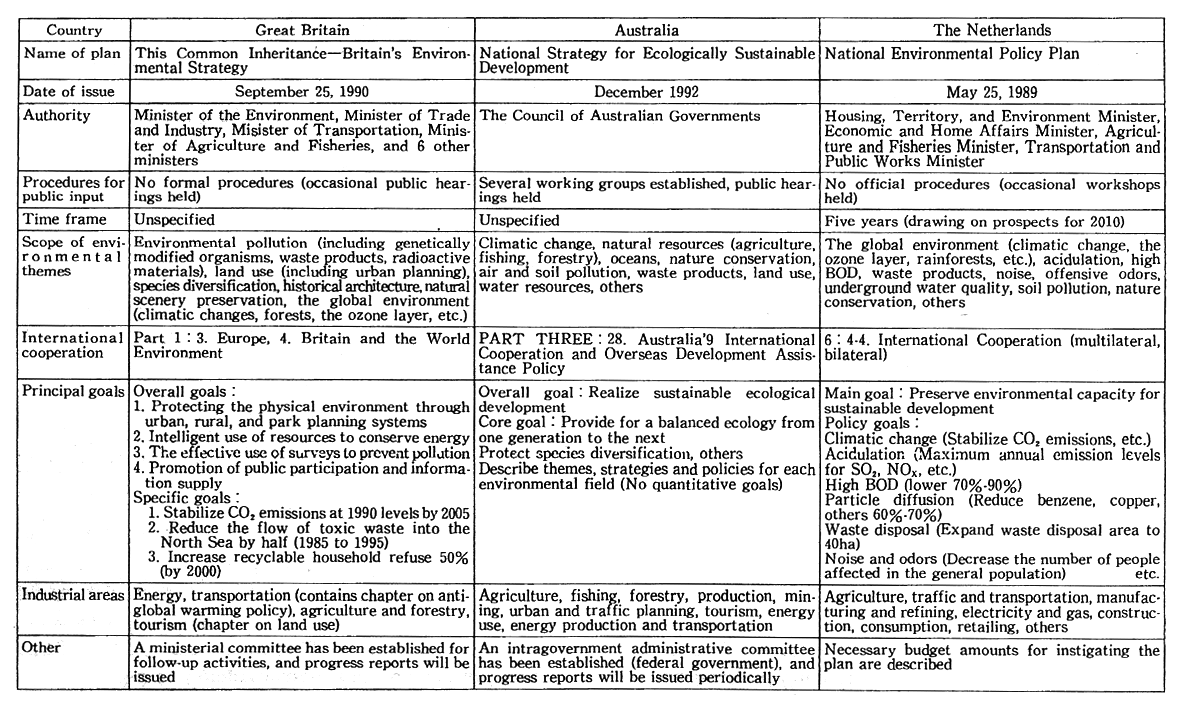
Table 3-2-1 Comprehensive Environmental Plans in Major Industrialized Countries
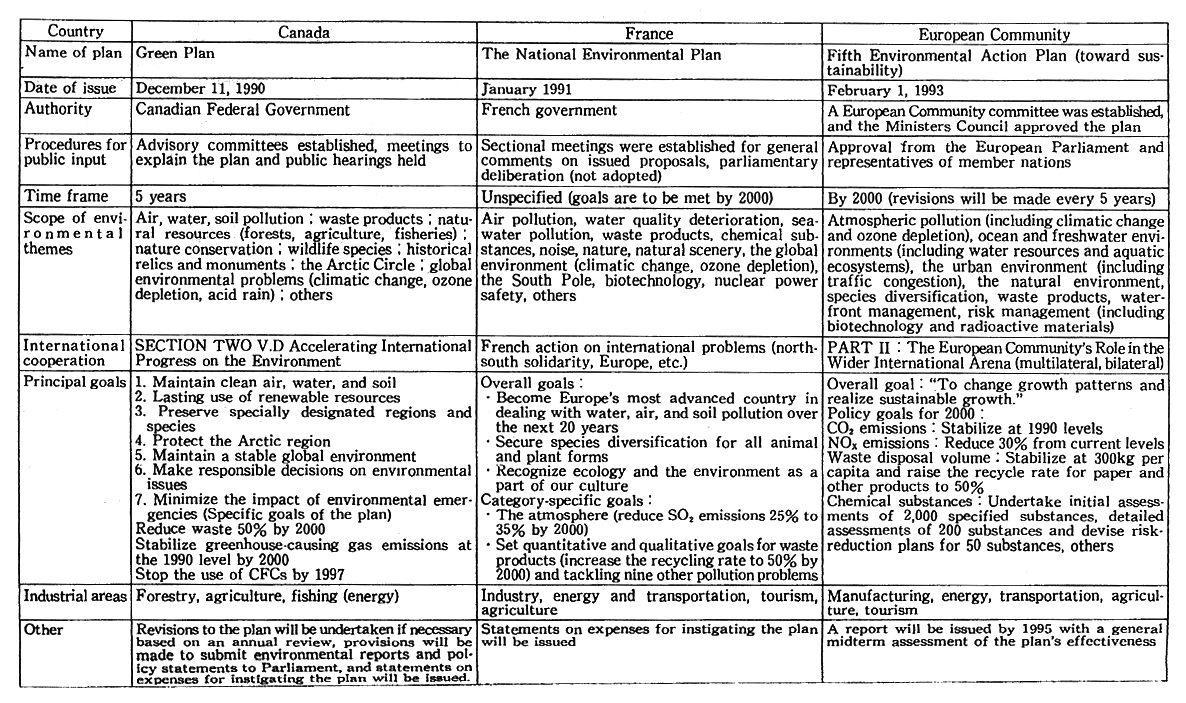
3-2-2 Economic Measures
(1) Conditions Surrounding Economic Measures in Japan and Abroad
Today, production, consumption, waste disposal, and other human socioeconomic activities have a large impact on the surrounding environment. Specifically, global warming, the destruction of the ozone layer, acid rain, and other environmental problems pose a threat to human existence in future generations. The costs of the burden on the environment resulting from human activities are difficult to fathom, and because these factors are not internalized or factored in the economy, the general burden on society and environmentally damaging practices continue. Thus, there is growing recognition worldwide of the need to take a leadership position in encouraging polluters themselves to work to reduce environmental strain by instigating fair and appropriate economic burden-sharing policies through market mechanisms. Also required is the provision of economic assistance that will enable such polluters to modify their operations and install environmental-friendly equipment. Considering the limits of existing regulatory policies amid the ongoing diversification and globalization of environmental problems, it could be said that that economic measures are attracting attention as more effective means to promote environmental preservation.
Economic measures, in comparison with direct regulations, have the following merits. First, applying regulatory measures to reduce CO2 and other emissions by a large number of polluters is extremely difficult because appropriate reduction quotas for individual companies and industries must be determined and reduction costs are apt to be immense. In contrast, economic measures allow polluters to make rational economic choices through market mechanisms and facilitate optimum labor distribution at minimal costs. Second, regulatory measures lack incentives for reducing pollution beyond the specified amount, whereas economic measures provide ongoing effective incentives linking reductions in pollution amounts with economic benefits. Further, reflecting the trend in recent years toward economic deregulation, there is a clear desire to keep regulations both transparent and to a minimum. In building a society that values personal responsibility, economic measures, compared with direct regulations, help create a social structure in which companies and organizations make independent decisions based on costs and benefits and, ultimately, are answerable for their own actions. It is also necessary to establish standards of behavior in the public consciousness to ensure that members of society and organizations take responsibility in promoting pollution reduction.
Next, international trends in economic measures are examined, Recent years have seen a rise in interest in the introduction of environmental taxes, surcharges, and other economic incentives, and a large number of countries are already levying surcharges on polluters (Table 3-2-2).
Table 3-2-2 Number of Economic Measures Applied in Selected Nations (January 1992)
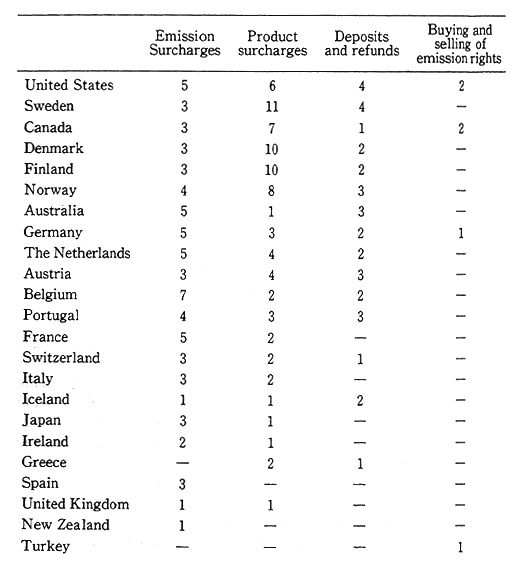
Source : OECD materials, 1993
At the July 1990 Houston Summit, the July 1991 London Summit, the July 1992 Munich Summit, and other international political forums, economic measures have been made important elements of environmental preservation policies.
The OECD, at a ministerial conference of the Environmental Commission held in January 1991, agreed to set a basic course for integrating environmental and economic policies and adopted and approved the OECD Board of Directors Advice on Use of Economic Measures for Environmental Policy to allow member nations to employ economic measures more effectively and in broader areas. The economic measures applied include (1) surcharges and taxes, (2) the buying and selling of emission rights in the market, (3) deposit systems, (4) funding assistance (subsidies). The report offers advice on their use in consideration of each nation's socioeconomic circumstances. Later, at a meeting of the OECD's Section on Taxes and the Environment in March 1993, debate took place on a number of points related to the introduction of environmental taxes, and a report was issued listing responses to the points discussed. Meanwhile, the EC Commission adopted an EC directive on the introduction of a carbon/energy tax on carbon fuel and energy amounts in May 1992, and the directive is currently under review by the EC Council.